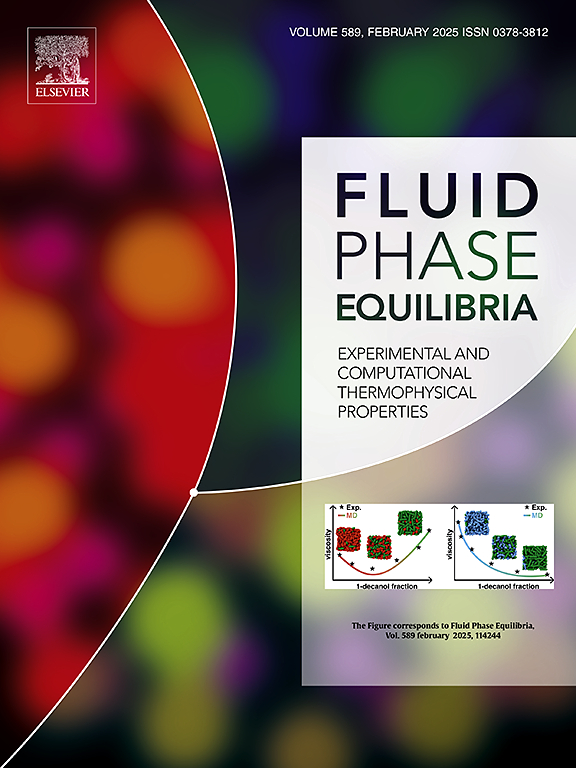Solid-liquid equilibrium of binary mixtures of triacylglycerols and fatty acids/alcohols
IF 2.7
3区 工程技术
Q3 CHEMISTRY, PHYSICAL
引用次数: 0
Abstract
Vegetable oils and fats are complex mixtures primarily composed of large quantities of triacylglycerols (TAGs) and small quantities of other chemicals, such as diacylglycerols, monoacylglycerols, fatty acids, and fatty alcohols. The individual components of these lipidic systems find several applications in lipid-based matrices, particularly in the food, cosmetic, and pharmaceutical industries. Understanding the solid-liquid equilibrium (SLE) data of (TAG)–fatty compound mixtures is essential for designing separation and purification processes to obtain the pure components from the natural complex mixtures.
In the present work, the solid-liquid phase diagrams of trilaurin and four fatty compounds (1-decanol, 1-dodecanol, capric acid, and lauric acid), as well as trilinolein and four other fatty compounds (1-hexanedecanol, 1-octadecanol, palmitic acid, and stearic acid), were determined using differential scanning calorimetry (DSC). Additionally, polarized optical microscopy was applied to complement the calorimetric studies. The trilaurin-based systems exhibit eutectic-type behavior, with eutectic points at ∼ 0.1 (trilaurin + capric acid) and ∼ 0.3 (trilaurin + lauric acid), whereas trilaurin + fatty alcohol mixtures showed eutectic transitions close to the composition of pure alcohol. In the case of the trilinolein mixtures, no eutectic transitions were detected, only the melting of the solid phase. To model the liquidus lines, Margules 2-suffix, Margules 3-suffix, and the UNIFAC models were applied and compared against the ideal approach. Among these, the Margules 3-suffix model provided the best fit (RMSD = 0.5 K), followed by the Margules 2-suffix (RMSD = 0.9 K), demonstrating their suitability for describing the SLE behavior of these systems.
三酰基甘油和脂肪酸/醇二元混合物的固液平衡
植物油和脂肪是复杂的混合物,主要由大量的三酰基甘油(TAGs)和少量的其他化学物质,如二酰基甘油、单酰基甘油、脂肪酸和脂肪醇组成。这些脂质系统的各个组成部分在脂基基质中有几种应用,特别是在食品、化妆品和制药工业中。了解(TAG) -脂肪化合物混合物的固液平衡(SLE)数据对于设计从天然复杂混合物中获得纯组分的分离和纯化工艺至关重要。本研究采用差示扫描量热法(DSC)测定了三叶草苷和四种脂肪化合物(1-癸醇、1-十二醇、癸酸和月桂酸)以及三叶草油苷和其他四种脂肪化合物(1-己烯癸醇、1-十八醇、棕榈酸和硬脂酸)的固液相图。此外,偏光光学显微镜被用于补充量热研究。基于三叶草苷的体系表现出共晶型行为,共晶点在xTLA ~ 0.1(三叶草苷+癸酸)和xTLA ~ 0.3(三叶草苷+月桂酸),而三叶草苷+脂肪醇混合物的共晶转变接近纯醇的组成。在三叶油混合物的情况下,没有共晶转变被检测到,只有固体相的熔化。为了模拟液相线,应用了Margules 2-suffix、Margules 3-suffix和UNIFAC模型,并与理想方法进行了比较。其中,Margules 3-suffix模型提供了最佳拟合(RMSD = 0.5 K),其次是Margules 2-suffix (RMSD = 0.9 K),证明它们适合描述这些系统的SLE行为。
本文章由计算机程序翻译,如有差异,请以英文原文为准。
求助全文
约1分钟内获得全文
求助全文
来源期刊

Fluid Phase Equilibria
工程技术-工程:化工
CiteScore
5.30
自引率
15.40%
发文量
223
审稿时长
53 days
期刊介绍:
Fluid Phase Equilibria publishes high-quality papers dealing with experimental, theoretical, and applied research related to equilibrium and transport properties of fluids, solids, and interfaces. Subjects of interest include physical/phase and chemical equilibria; equilibrium and nonequilibrium thermophysical properties; fundamental thermodynamic relations; and stability. The systems central to the journal include pure substances and mixtures of organic and inorganic materials, including polymers, biochemicals, and surfactants with sufficient characterization of composition and purity for the results to be reproduced. Alloys are of interest only when thermodynamic studies are included, purely material studies will not be considered. In all cases, authors are expected to provide physical or chemical interpretations of the results.
Experimental research can include measurements under all conditions of temperature, pressure, and composition, including critical and supercritical. Measurements are to be associated with systems and conditions of fundamental or applied interest, and may not be only a collection of routine data, such as physical property or solubility measurements at limited pressures and temperatures close to ambient, or surfactant studies focussed strictly on micellisation or micelle structure. Papers reporting common data must be accompanied by new physical insights and/or contemporary or new theory or techniques.
 求助内容:
求助内容: 应助结果提醒方式:
应助结果提醒方式:


